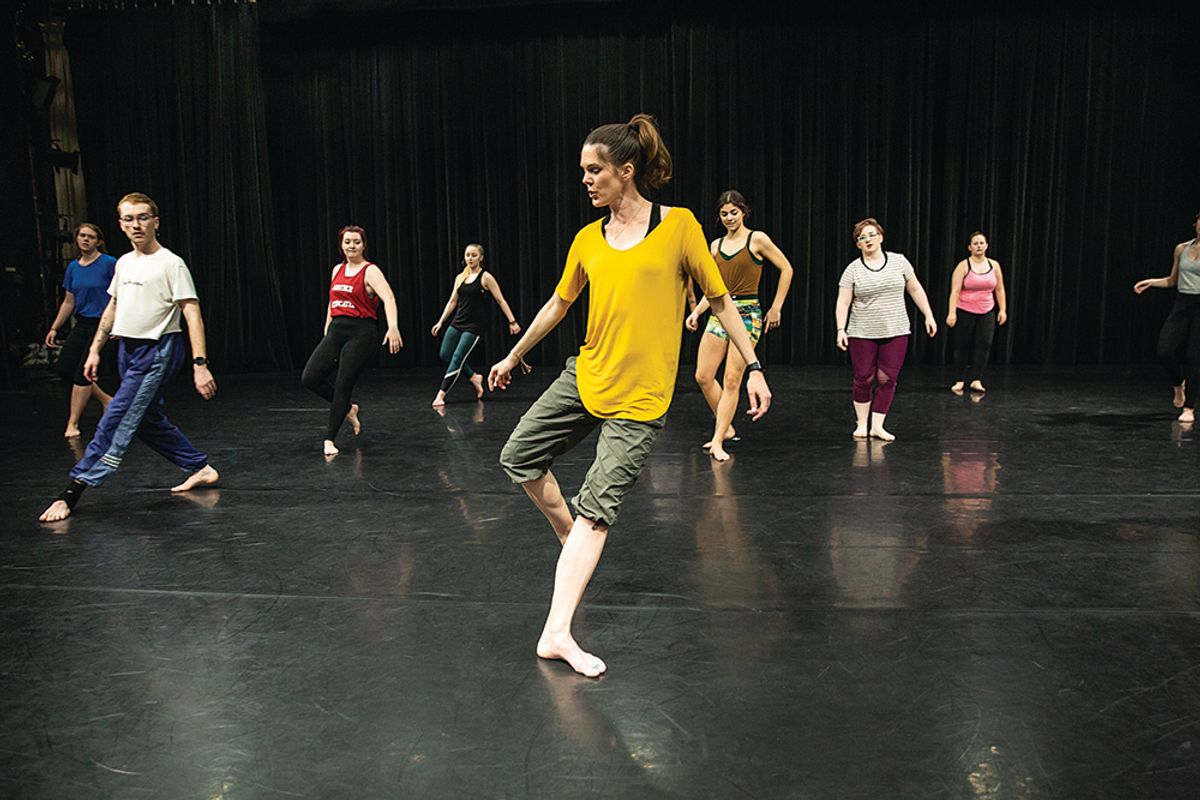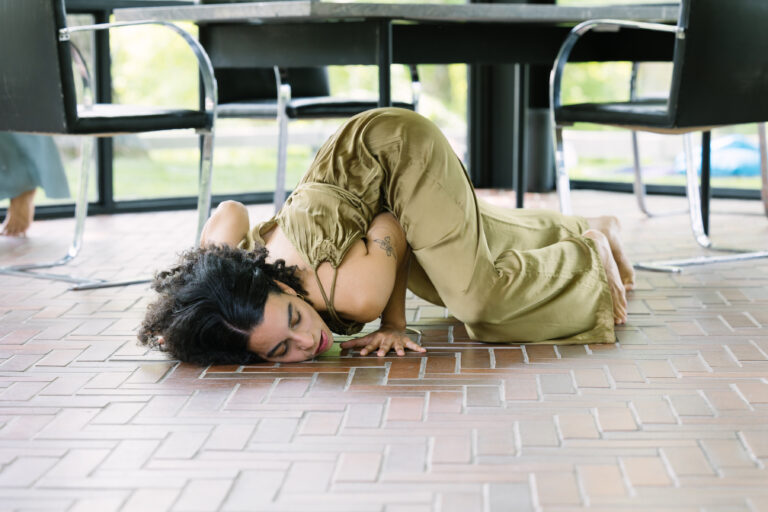
It’s the last class of the spring semester, and Paige Cunningham Caldarella isn’t letting any of her advanced contemporary students off the hook. After leading them through a familiar Merce Cunningham–style warm-up, full of bounces, twists and curves, she’s thrown a tricky five-count across-the-floor phrase and a surprisingly floor-heavy adagio at the dancers. Now, near the end of class, she is reviewing a lengthy center combination set to a Nelly Furtado song. The phrase has all the hallmarks of Cunningham—torso twists atop extended legs, unexpected timing, direction changes—which means it’s a challenge to execute well.
After watching the dancers go through the phrase a couple of times, Caldarella takes a moment to troubleshoot a few sticky spots and give a quick pep talk before having them do it again. “I know it’s fast,” she tells them. “I know it’s a lot of moves. And you’re hanging in there! But stick with the task of articulating everything—try to hyper-explore that.”
She pauses for a moment, and then smiles. “After all,” she reminds them, “this is the last class. What do you have to lose?” The pep talk works: This time, the dancers nail the timing, which gives them the freedom to find the length of every développé and hit each step of even the fastest triplet. Class ends on a high note.
In today’s higher-ed dance landscape, it’s rare to find a technique class devoted to one technique. Few dancers graduate and go on to join a company that is steeped in a single technique, like that of Martha Graham or José Limón. Students now take a variety of modern classes, with a little bit of everything thrown in—release technique, contemporary, Bartenieff Fundamentals. But Caldarella, who performed with Merce Cunningham Dance Company from 2000 to 2004, is committed to keeping Cunningham relevant for this generation of Columbia College Chicago dancers, even as she continues to discover on her own what makes this technique special and worthy of continued attention.
“With the current generation of college students, technology plays such a huge role in their life—this ability to be on six different devices at once,” she says. “Cunningham feels like the physical solution for multitasking in the body. You might have your leg out to the side as you’re tilting in the opposite direction. A lot has to go on in your body at once.”
That multitasking approach can lead to frustration, Caldarella has noticed, which doesn’t always sit well with her Generation-Z students. “I was talking with a student the other day who said, ‘My generation has been taught not to fail,'” she says. “This whole idea of ‘teach to the test’ means failure is such a bad thing. But this is a space where you can create, you can make mistakes, you can figure things out. That’s what Merce did. He opened up the space to take the time to figure it out.”
Caldarella readily admits that she didn’t have all of this figured out during her tenure with the company, which she had joined as a brand-new Juilliard graduate. “I don’t think I recognized wholeheartedly what I was a part of,” she says. “I was very young and naive. At that point, Merce was still teaching class. He was such a gentle soul. He didn’t say much, and at the time, I didn’t understand that he didn’t say much because he was really allowing space for people to figure things out for themselves and not mandating what he wanted them to do.”
Now, after honing her teaching style at Columbia for the last 12 years, she has a much clearer idea of how to pass on the knowledge she’s accumulated—and had time to let marinate—about this famously difficult technique. “I try to be very transparent from the very beginning, telling the students about my own personal highs and lows, what I struggle with,” she says. “It’s me letting them know: I recognize what you are doing, and I know how hard it is, and we’re in it together.”
Much of this year has been spent looking backward in time. This year is the centennial of Cunningham’s birth, and Caldarella has taught for an American College Dance Association regional conference in March and three solos for Night of 100 Solos: A Centennial Event at the Brooklyn Academy of Music in April, where a new generation of dancers performed Cunningham’s work for the first time. “I’ve been looking at a lot of old Cunningham footage, and there’s so much about finding your own way into the movement,” she says. “When I look at dancers in his company doing the same phrase, they have very different interpretations—all equally gorgeous. There’s something about that individuality in this work.”
And that’s just one more reason why she knows that it makes sense to keep teaching college dancers a technique that’s more than 50 years old. “I think about how much this generation is into their individuality,” she says. “They really just want to be themselves.”
Dance Teacher Magazine Technique Sept/Oct 2019
www.youtube.com




